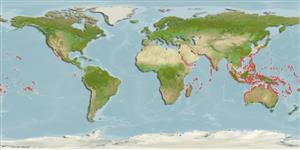Common names from other countries
Environment: milieu / climate zone / depth range / distribution range
Sinh thái học
Cùng sống ở rạn san hô; Mức độ sâu 0 - 10 m (Ref. 96667). Tropical
Indo-Pacific: from East Africa to French Polynesia.
Length at first maturity / Bộ gần gũi / Khối lượng (Trọng lượng) / Age
Maturity: Lm ? range ? - ? cm Max length : 10.0 cm CL con đực/không giới tính; (Ref. 128968)
The carapace has protruding frontal borders which are divided into four lobes (first three are rounded and the fourth is tooth-like. The body is covered with eye-like chocolate brown spots and smooth, well-defined lobules. Both front pincers are of the same size, while the walking legs are fringed with long hairs (Ref. 128968).
Adults occur in coral reefs, hidden under rocks during the day. Nocturnal (Ref. 128968). The shell and flesh of this species contain neosaxitoxin, saxitoxin, and tetrodotoxin (Ref. 107779, 128965) which have been proven to be fatal when ingested (Ref. 128965).
Life cycle and mating behavior
Chín muồi sinh dục | Sự tái sinh sản | Đẻ trứng | Các trứng | Sự sinh sản | Ấu trùng
Members of the order Decapoda are mostly gonochoric. Mating behavior: Precopulatory courtship ritual is common (through olfactory and tactile cues); usually indirect sperm transfer.
MarineSpecies.org. 2050. (Ref. 3477)
IUCN Red List Status (Ref. 130435: Version 2024-1)
CITES status (Ref. 108899)
Not Evaluated
Not Evaluated
Threat to humans
Poisonous to eat (Ref. 107779)
Human uses
Các nghề cá: Tính thương mại
| FishSource | Biển chung quanh ta
Các công cụ
Thêm thông tin
Age/SizeSự sinh trưởngLength-weightLength-lengthHình thái họcẤu trùngSự phong phú
Các nguồn internet
Estimates based on models
Preferred temperature
(Ref.
115969): 24.6 - 29.3, mean 28.3 (based on 3236 cells).
Vulnerability
Low vulnerability (10 of 100).
Price category
Unknown.
